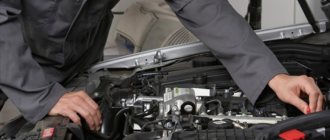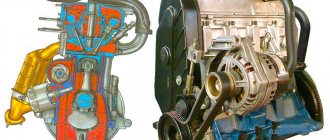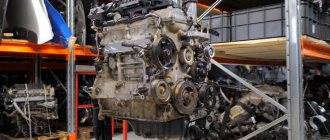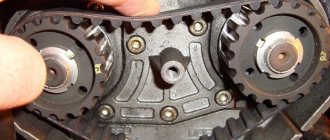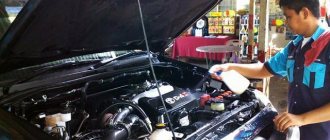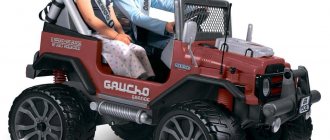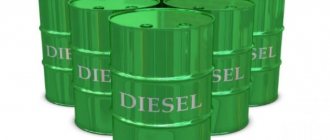Technical characteristics of the Toyota 1MZ-FE 3.0 liter engine
Powertrain version without VVT-i
| Exact volume | 2994 cm³ |
| Supply system | MPI injector |
| Engine power | 168 - 194 hp |
| Torque | 248 - 275 Nm |
| Cylinder block | aluminum V6 |
| Block head | aluminum 24v |
| Cylinder diameter | 87.5 mm |
| Piston stroke | 83 mm |
| Compression ratio | 10.5 |
| Features of internal combustion engines | No |
| Hydraulic compensators | No |
| Timing drive | belt |
| Phase regulator | No |
| Turbocharging | No |
| What kind of oil to pour | 4.7 liters 5W-30 |
| Fuel type | AI-92 |
| Environmental class | EURO 2/3 |
| Approximate resource | 450,000 km |
Powertrain version with VVT-i
| Exact volume | 2994 cm³ |
| Supply system | MPI injector |
| Engine power | 210 - 220 hp |
| Torque | 301 - 328 Nm |
| Cylinder block | aluminum V6 |
| Block head | aluminum 24v |
| Cylinder diameter | 87.5 mm |
| Piston stroke | 83 mm |
| Compression ratio | 10.5 |
| Features of internal combustion engines | electronic throttle |
| Hydraulic compensators | No |
| Timing drive | belt |
| Phase regulator | VVT-i intake |
| Turbocharging | No |
| What kind of oil to pour | 4.7 liters 5W-30 |
| Fuel type | AI-95 |
| Environmental class | EURO 3/4 |
| Approximate resource | 400,000 km |
2MZ-FE
The 2MZ-FE engine has a volume of 2.5 liters (2496 cc), replacing the 4VZ-FE with the world famous 2.5 liter V6. The cylinder bore is 87.5 mm and the piston stroke is 69.2 mm. Engine power 200 hp (150 kW) at 6000 rpm and torque of 244 Nm at 4600 rpm.
2MZ-FE was installed on cars:
- Toyota Camry (Japanese, New Zealand and others, except the American market)
- Toyota Windom (Japanese domestic market) (1996-2001)
- Toyota Mark II Qualis (Japanese domestic market)
Fuel consumption 1MZ-FE
Without VVT-i using the example of a 2001 Toyota Camry with an automatic transmission:
| City | 15.7 liters |
| Route | 8.3 liters |
| Mixed | 11 liters |
With VVT-i using a 2001 Lexus ES 300 with an automatic transmission as an example:
| City | 11.2 liters |
| Route | 8.1 liters |
| Mixed | 9.7 liters |
Similar engines from other manufacturers:
3MZ-FE[ | ]
3MZ-FE
The 3MZ-FE engine has a displacement of 3.3 liters (3310 cc). The cylinder diameter is 92 mm and the piston stroke is 83 mm. Engine power 225 hp. (168 kW) and 325 Nm of torque on Camry cars and 230 hp. (172 kW) and 328 Nm of torque on Sienna and Highlander. The engines use VVT-i, ETCS-i, ABS systems, and the throttle valve diameter is increased to 1MZ.
3MZ-FE was installed on cars:
- Toyota Highlander (2004—2007)
- Toyota Camry Solara (2004—2008)
- Toyota Sienna (2004—2006)
- Toyota Camry (2004—2006)
- Toyota Highlander Hybrid (reduced power, 2005—2010)
- Lexus RX 330 (American market, 2003—2006)
- Lexus RX 400h (reduced power, 2006—2009)
- Lexus ES 330 (2004—2006)
- Mitsuoka Orochi (2006—2014)
What cars were equipped with the 1MZ-FE engine?
Toyota
| Camry XV10 | 1993 — 1996 |
| Camry XV20 | 1996 — 2001 |
| Camry XV30 | 2001 — 2006 |
| Avalon XX10 | 1994 -1999 |
| Avalon XX20 | 1999 -2004 |
| Sienna XL10 | 1997 — 2002 |
| Mark II Wagon X100 | 1997 — 2001 |
| Solara XV20 | 1999 — 2003 |
| Estima XR30 | 2000 — 2005 |
| Alphard AH10 | 2002 — 2008 |
| Highlander XU20 | 2000 — 2003 |
Lexus
| ES 300 XV10 | 1993 — 1996 |
| ES 300 XV20 | 1996 — 2001 |
| ES 300 XV30 | 2001 — 2003 |
| RX 300 XU10 | 1998 — 2003 |
2MZ-FE[ | ]
The 2MZ-FE engine has a volume of 2.5 liters (2496 cc), replacing the 4VZ-FE with the world famous 2.5 liter V6. The cylinder bore is 87.5 mm and the piston stroke is 69.2 mm. Engine power 200 hp (150 kW) at 6000 rpm and torque of 244 Nm at 4600 rpm.
2MZ-FE was installed on cars:
- Toyota Camry (Japanese, New Zealand and others, except the American market)
- Toyota Windom (Japanese domestic market) (1996-2001)
- Toyota Mark II Qualis (Japanese domestic market)
Disadvantages, breakdowns and problems of Toyota 1MZ-FE
On long runs it often develops an impressive oil burn.
The reliability of knock sensors is quite low, they often have to be replaced
Engine speed fluctuates due to throttle valve contamination
The engine suffers greatly when the VVT-i phase regulator valve fails
This power unit is very afraid of overheating; you should not let it boil
Drivers periodically complain about refusal to start in severe frost
The engine is prone to increased carbon formation, especially in the collectors
You can contact the site administrator by email: [email protected]
All texts were written by me, are authored by Google, included in the original Yandex texts and notarized. For any borrowing, we immediately write an official letter on company letterhead in support of search networks, your hosting and domain registrar.
Next we go to court. Don’t try your luck, we have more than thirty successful Internet projects and have already won a dozen lawsuits.
The MZ series of the Toyota manufacturer includes naturally aspirated V-shaped gasoline engines with an angle of 60 degrees between 3 pairs of cylinders inside an aluminum block. The 1MZ FE engine has a forged steel crankshaft and an improved valve design, which reduces the likelihood of bending when impacting the pistons after a timing belt break.
Read more: 12 to 24 car inverter
Advantages and disadvantages of Toyota 3MZ-FE
The camshaft is cast from steel, and the auto starter manifold is made from aluminum. All engines in this series are quite lightweight, and this was facilitated by the use of a special aluminum alloy, with which most of the engine parts are made. In addition, this factor made it possible to reduce the cost of the power unit without compromising reliability.
3MZ-FE vvt-i v6
All engines in this series were equipped with cast aluminum pistons, which also have an anti-friction polymer coating. The engine uses a forged steel crankshaft. Special engine valves significantly reduce the likelihood of impact with the pistons as a result of a broken belt. This series was replaced by GR series engines.
Speaking about the shortcomings, we can say that there are practically none, except for the significant consumption of oil and gasoline, but this is quite justified.
Technical specifications 1MZ FE 3.0 l/168 – 220 l. With.
Within its MZ series, the 1MZ FE engine has the following features:
What makes this series special is the fact that in 1997, Toyota management decided to increase power by turbocharging the engine. The turbo kit was developed by the Racing Development subsidiary TRD for the Toyota Camry, Sienna and Solara, allowing it to develop a power of 242 hp. With.
Then the engine layout was changed, a VVTi fluid coupling was installed on the intake camshaft to adjust the valve timing. The first engines with a phase twister were equipped with an intake manifold with variable geometry. The cast silumin body contained a damper with two volutes of different lengths and an EGR exhaust recirculation valve.
Then the intake tract was modernized, the throttle received electronic control, but lost its variable geometry. The intake manifold became polymer to reduce cost and lighten the design of the internal combustion engine. A 1996 Ward's magazine ranking listed the 1MZ FE as one of the top 10 gasoline powertrains.
Tabular technical characteristics of 1MZ FE are presented below:
| Manufacturer | Toyota |
| Engine brand | 1MZ FE |
| Years of production | 1994 – 2007 |
| Volume | 2995 cm3 (3.0 l) |
| Power | 123.6 – 161.8 kW (168 – 220 hp) |
| Torque moment | 248 – 261 Nm (at 4200 rpm) |
| Weight | 158 kg |
| Compression ratio | 10,5 |
| Nutrition | injector |
| Motor type | V-type petrol |
| Ignition | DIS-3/DIS-6 |
| Number of cylinders | 6 |
| Location of the first cylinder | TVE |
| Number of valves on each cylinder | 4 |
| Cylinder head material | aluminum alloy |
| Intake manifold | duralumin |
| An exhaust manifold | cast iron |
| Camshaft | 4 pieces, 2 x DOHC V12 |
| Cylinder block material | Aluminium alloy |
| Cylinder diameter | 87.5 mm |
| Pistons | cast aluminum |
| Crankshaft | cast iron 5 support 8 counterweights |
| Piston stroke | 83 mm |
| Fuel | AI-92/95 |
| Environmental standards | Euro-3/4 |
| Fuel consumption | highway – 8.3 l/100 km |
combined cycle 11 l/100 km
city – 15.7 l/100 km
Oil consumption 0.6 - 1 l/1000 km Which oil to pour into the engine by viscosity 5W30, 5W40, 10W30, 0W40 Which oil is best for the engine by manufacturerLiqui Moly, Toyota Oil for 1MZ FE by composition synthetic, semi-synthetic Engine oil volume 4.7 l Operating temperature 95° Engine life declared 250,000 kmreal 350000 km
Valve adjustment washer Forced cooling system, antifreeze Coolant volume 9 l, Tanikawa Yuka Kogyo Pump GMB GWT-92ASpark plugs for 1MZ FEIFR6T-11 from NGK or Denso SK20R11, IK20 Spark plug gap 1.1 mm Timing belt Toyota 13568-YZZ10 Cylinder operating order 1-2-3-4 -5-6Air filterStellox 71-01068 -SX, Parts Mall PAF-062 Oil filterToyota 90915YZZJ1, Blue Print ADT32109, Nipparts J1312018 Lightweight flywheel, 8 holes, for 300 mm clutch Flywheel mounting bolts M12x1.25 mm, length 26 mm Oil seals, manufacturer Goetze Compression from 13 bar , the difference in adjacent cylinders is maximum 1 bar. Speed XX750 – 800 min. -1 Tightening force of threaded connections of the spark plug – 27 Nmflywheel – 108 Nm
clutch bolt – 66 Nm
bearing cap – 84 Nm (main) and 48 Nm (connecting rod)
cylinder head – three stages 20 Nm, 85 Nm + 90°
1MZ-FE
The 1MZ-FE engine has a displacement of 3.0 L (2994 cc). The cylinder bore is 87.5 mm and the piston stroke is 83 mm. Engine power 168-220 hp. at 5200-5400 rpm, torque 248-261 Nm at 4400 rpm. Engine power fell after the Society of Automotive Engineers introduced a new power measurement system, with Toyota's 87 octane engines dropping the most compared to the same engines used in Lexus' 91 octane. In general, these engines are highly reliable, and with proper operation, the engine life is more than 300,000 km.
The 1MZ-FE was on Ward's 10 Best Engines list in 1996. TRD offered a supercharger kit for the Camry (1997-2000), Sienna (1998-2000) and Solara (1999-2000). Power increased to 242 hp. and torque 328 Nm.
1MZ-FE with VVT-i is used in Avalon, Highlander, Sienna and Camry. These engines produce up to 220 hp. (161.8 kW) at 5800 rpm with 301 Nm of torque at 4400 rpm. Early versions of the 1MZ with VVT-i use a dual throttle body and a cast aluminum intake manifold. Later versions use electronic throttles.
1MZ-FE was installed on cars:
- Toyota Camry (1994—2006)
- Lexus ES 300 and Toyota Windom (Japanese domestic market, 1994–2003)
- Toyota Avalon and Toyota Pronard (Avalon for the Japanese domestic market, 1996–2004 and 2000)
- Toyota Harrier (Asian market)
- Toyota Sienna (1998—2000)
- Toyota Solara (1999—2003)
- Toyota Estima (Japanese domestic market, 2000–2005)
- Lexus RX 300 (American market, 1999–2003; Asian and European markets, 2003–2006)
- Lexus ES 300 (2000—2003)
- Toyota Avalon (2000—2004)
- Toyota Highlander/Kluger (2001—2007)
- Toyota Sienna (2001—2003)
- Toyota Alphard (Japanese domestic market, 2002–2007)
- Toyota Camry (2003—2006)
- Toyota Windom (Japanese domestic market) (2001-2006)
Design Features
In the first years of production, the 1MZ FE engine had some design features:
- V-shaped internal combustion engine architecture with an angle of 60 degrees between the cylinders;
- aluminum block with dry cylinders made of permanent cast iron liners, cast in place;
- DOHC 12V double cylinder head on each side of the block;
- throttle body with adjustable geometry (double scroll);
- DIS-3 direct ignition system.
Then some changes were made to the design:
- mounted - fixed geometry receiver with electronic control;
- synchronous ignition system to eliminate signals at the time of release of DIS-6.
In the "type '95" version, the 1MZ FE engine does not have collision between valves and pistons. After installing the VVTi fluid coupling on the intake camshaft, the same engine bends the valves with pistons due to a design change.
List of internal combustion engine modifications
During the existence of 1MZ-FE, the internal combustion engine device was modified, but the marking remained the same, so the version with timing adjustments using VVTi couplings can be considered a modification of the engine conditionally. Later, the attachments partially changed - instead of a throttle valve with two scrolls of different lengths, an electronically controlled throttle was used.
Read more: The cost of registering a traffic police station at the traffic police
Advantages and disadvantages
- resource more than 350,000 km;
- dynamic characteristics at all speeds;
- engine versions without VVTi do not bend valves when the belt drive breaks;
- modifications with phase adjustment are more economical and faster.
There are problems with winter start-up and intense thermal conditions in summer. The injectors have O-rings and air passages added to them, making them much more expensive than standard Bosch injectors.
Advantages and disadvantages
In fact, Toyota 1MZ-FE engines were an improved version of the VZ series power units. The crankcase of this engine was made of light alloy aluminum with press-fitted piston liners. A special feature of this crankcase is the impossibility of boring cylinder liners to the repair size. Therefore, it is generally accepted that a major overhaul of the 1MZ-FE cannot be carried out. In addition, judging by the reviews, the 1MZ-FE is negatively affected by overheating.
1MZ-FE
Another unpleasant feature of this unit is its tendency to increased carbon formation and coking of the oil. The reason for this is the characteristics of the cooling system and intense thermal conditions.
But even with such shortcomings, the engine is quite reliable; the service life of the 1MZ-FE exceeds 500 thousand kilometers, subject to proper and timely maintenance. Another positive characteristic of the 1MZ-FE is its almost silent operation.
List of car models in which it was installed
In three versions over the years of its existence, the 1MZ FE engine could be found under the hood of the following Toyota cars:
- Avalon – 1996 – 2004, flagship sedan, produced in the Middle East and North America;
- Windom – 1996 – 2003, only for the domestic market, Premium class sedan;
- Sienna – 1998 – 2000, minivan for South Korea and North America;
- Camry Solara – 1999 – 2003, coupe and convertible;
- Estima - 2000, only within Japan, stylish minivan;
- Harrier – 2001 – 2005, mid-size crossover for Japan;
- Pronard – 2000, full-size sedan for foreign markets.
Maintenance schedule 1MZ FE 3.0 l/168 – 220 l. With.
The official manufacturer's manual includes maintenance dates for the 1MZ FE engine of the following type:
- after 10 thousand km of operation of the engine oil and full-flow filter, the lubricant should be replaced;
- the manufacturer recommends using a new timing belt after 75 thousand mileage;
- The battery manufacturer indicates a power source life of 3–5 years, depending on the design;
- Toyota plant specialists advise changing the coolant at 50 thousand km;
- It is recommended to change the air filter annually, and the fuel filter after 30,000 miles;
- 1MZ FE engines do not have hydraulic compensators, so the thermal clearances of the valves should be adjusted with washers every 30,000 km;
- the exhaust manifold burns out after 70 - 100 thousand km;
- the crankcase ventilation becomes clogged and needs to be cleaned after about 20,000 miles;
- spark plugs fail after 20,000 km.
The pump is driven by a timing belt, so parts are replaced together to ensure the same service life.
Review of faults and methods for repairing them
During operation, the 1MZ FE motor is susceptible to some “diseases” due to its design features:
| Floating speed | 1) EGR valve clogged |
2) failure of the VVTi coupling
3) clogged injectors
4) clogged throttle valve
1) replacing the recirculation valve2) phase shifter repair
3) cleaning or replacing injectors
4) cleaning the throttle
Reduced torque 1) failure of the knock sensor 2) engine wear 1) replacement of the sensor2)repair
Increased lubricant consumption, wear of caps and rings, replacement of caps and ringsCast iron valve liners cast into an aluminum block are irreparable, so everything in the engine can be replaced except the cylinder block.
Engine tuning options
The 1MZ FE engine was installed in cars for the foreign market, so KIT kits were produced by both the TRD subsidiary and third-party manufacturers. Supercharged tuning is performed as follows:
- installation of intercooler and compressor 0.5 bar;
- injectors in the ramp 320 – 360cc;
- change in the cross-section of the exhaust pipe by 2.5 inches;
- The firmware version is included in the KIT kit; an adapter is required for installation.
Such tuning will provide power in the region of 270 hp. pp., but will reduce the service life. Mechanical tuning for this engine is limited, since it is impossible to bore the cylinders, and it is very expensive to change 4 camshafts or 24 valves at once.
Thus, the 1MZ FE engine has a power of 168 - 220 hp in different years of production. With. and high torque. A service life of 300 thousand km is considered very high, but overhaul of an aluminum cylinder block with non-removable liners is impossible.
3.8k Views
The Japanese automobile concern Toyota, when producing new cars, is trying to improve the power plants that are used in them. Engine production is carried out in stages. On the third of them, the 1MZ-FE engine was produced. This engine was installed on Toyota vehicles from 1994 to 2006. Dynamic performance, as well as the degree of reliability, allowed this power unit to take a place in the TOP 10 among the best engine units in the world in this class.
More about the engine
The power unit labeled 3VZ, production of which ended in 1994, is the predecessor of the 1MZ engine. The volume of six V-shaped working cylinders of the 1MZ is 3 liters. The block in which they are located is made of aluminum. The engine also contains: a forged crankshaft, a lightweight piston group, an exhaust gas recirculation mechanism, and an ACIS exhaust manifold with the function of changing the geometry of air flow.
Read more: New brake pads squeak when braking
The tilt angle of the cylinders is 60 degrees. The gas distribution phases are changed using the VVT-i system. Valve clearances must be adjusted every 100 thousand km. Mileage, since the 1MZ engine does not have hydraulic compensators. Otherwise, the power plant in question remains a typical Toyota engine. However, most owners of cars with this engine do not perform this procedure in practice.
Specifications
The 3MZ FE engine is a V-type with six cylinders, which has cast iron liners, which is good enough for repairs. The cylinder head is 16-valve with two camshafts. Injection is multi-point electronic.
Aluminum intake and exhaust manifold. As for the camshafts, they are steel. The pistons are made of cast aluminum, which gives strength and lightens the weight of the power unit as a whole.
The only big drawback is the increased consumption of gasoline and oil, but otherwise the engine is simply gorgeous.
Technical characteristics of 3MZ FE:
| Name | Characteristics |
| Manufacturer | Toyota Motor Corporation |
| Engine model | 3MZ FE |
| Volume | 3.3 liters (3310 cm3) |
| Injection system | Injector |
| Number of cylinders | 6 |
| Number of valves | 24 |
| Cylinder diameter | 82.0 – 92.0 mm |
| Power | 208-233 hp |
| Torque | 287 (29) / 3600 287 (29) / 440 288 (29) / 4400 298 (30) / 3600 301 (31) / 3600 |
325 (33) / 3600 328 (33) / 3600 328 (33) / 4400 331 (34) / 3600
Toyota Highlander, Highlander Hybrid;
Lexus RX 330, RX 400h;
What cars was it installed on?
Engines with the 1MZ-FE index were used on the following “E” class cars:
- Toyota Camry (V6).
- Toyota Avalon, Toyota Pronard.
- Toyota Windom, Lexus ES 300.
- Toyota Sienna.
- Toyota Solara (V6).
- Harrier, Lexus RX 300.
- Kluger.
- Highlander.
- and minibuses Estima and Alphard.
| Manufacturer's name | Kamigo Plant Toyota Motor Manufacturing Kentucky |
| Engine markings | Toyota 1MZ |
| Release period | 1994-2007 |
| The material from which the cylinder block is made | aluminum |
| Power system type | injection |
| Cylinder arrangement | V-shaped |
| Number of cylinders | 6 |
| Number of valves | 24 |
| Piston stroke, mm | 83 |
| Cylinder diameter, mm | 87.5 |
| Compression level | 10.5 |
| Volume of working cylinders, cubic cm | 2995 |
| Power indicators hp/rpm | 190/5400 210/5800 |
| Torque indicators, Nm/rpm | 275/4400 328/4400 |
| Fuel type | Gasoline AI-95 |
| Environmental class | Euro 4 |
| Engine weight, kg | 158 |
| Fuel consumption, l/100 km (for Camry XV30) - Urban cycle - Extra-urban cycle - Combined cycle | 15.7 8.3 11.0 |
| Lubricant consumption, g/1000 km | up to 1000 |
| Type of lubricating fluid in the engine | 5W-30 10W-30 |
| Engine oil quantity | 4.7 |
| Oil change frequency, km | 10000 (better 5000) |
| Engine operating temperature, degrees. | — |
| Approximate engine life, without major repairs, thousand km - according to the plant - in practice | n.d. 300+ |
3MZ-FE
3MZ-FE
The 3MZ-FE engine has a displacement of 3.3 liters (3310 cc). The cylinder diameter is 92 mm and the piston stroke is 83 mm. Engine power 225 hp. (168 kW) and 325 Nm of torque on Camry cars and 230 hp. (172 kW) and 328 Nm of torque on Sienna and Highlander. The engines use VVT-i, ETCS-i, ABS systems, and the throttle valve diameter is increased to 1MZ.
3MZ-FE was installed on cars:
- Toyota Highlander (2004—2007)
- Toyota Camry Solara (2004—2008)
- Toyota Sienna (2004—2006)
- Toyota Camry (2004—2006)
- Toyota Highlander Hybrid (reduced power, 2005—2010)
- Lexus RX 330 (American market, 2003—2006)
- Lexus RX 400h (reduced power, 2006—2009)
- Lexus ES 330 (2004—2006)
- Mitsuoka Orochi (2006—2014)
Malfunctions of the 1MZ problem and their causes
- high oil consumption. At the moment, all 1MZ engines have gone through enormous mileage. Therefore, high oil consumption is not a surprise. If this malfunction occurs, it is necessary to replace the oil scraper rings and caps;
- traction disappears, as a result of which the acceleration dynamics of the car are at a low level. In this case, it is necessary to replace the knock sensor, which is a weak point in 1MZ engines;
- uneven crankshaft rotation speed. It is necessary to clean the block where the throttle valve and injectors are located. Also, the cause of this problem may be a malfunction of the valve timing system. If it fails, engine vibration may occur.
Often 1MZ engines coke because the VVT-i clutch leaks over time. Official data from Toyota says that the 1MZ engine cannot be repaired. Therefore, in case of complete failure, it is necessary to replace it with a contract unit. Some unofficial service centers are engaged in the restoration of aluminum blocks. Adequate and careful operation contributes to the long-term service of the 1MZ engine, which can cover a mileage of 300 thousand km without major repair work.
We can summarize: standard 1MZ power units are good units that require special maintenance conditions.
Compressor on 1MZ (Supercharger)
Compressor supercharging is the most common and simplest method that helps increase the power parameters of the 1MZ engine. For example, a TRD unit can operate on a native piston system, and it is capable of creating an additional pressure of 0.5 bar. However, when using it, it is necessary to replace the fuel pump with a product labeled Walbro 255 lph, and increase the productivity of the injectors to 320-360 cc. , and also install an exhaust system with a diameter of at least 2.5 inches. The cost of these operations is very high.
To reduce costs, some car enthusiasts buy used kits or assemble them themselves using an Eaton M62 compressor unit, and then roll the engine online. In any case, the car owner will spend a lot of money and will not get the expected result. If you have a lot of money and a desire to drive fast, you should take a closer look at the power unit labeled JZ, the dynamic qualities of which are at the highest level.
We bring to your attention the price list for the contract engine (without mileage in the Russian Federation) 1MZ-FE
